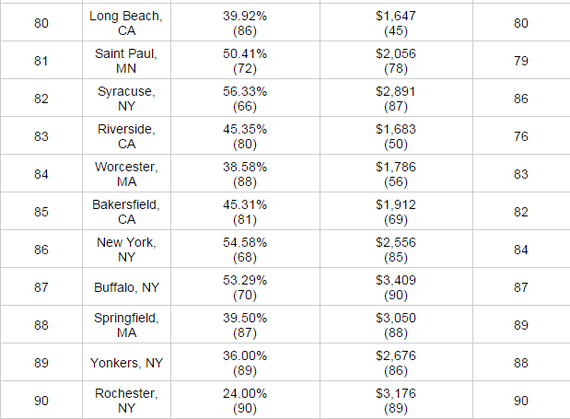Where School Dollars Go to Waste
"Why throw money at problems? That is what money is for."—Kurt Vonnegut

America spends tons of money on education even though the final product isn't very impressive. If children are indeed the future, then they're certainly an expensive one: Of the $3.2 trillion in total expenditures for local and state governments in 2012, education accounted for nearly 28 percent, or $869.2 billion, according to the latest data from the Census Bureau. That figure topped government spending in any other sector, almost doubling the second-largest recipient of taxpayer dollars—public welfare.
Local and State Spending by Sector

But while much attention centers on how much schools are spending, it's also worth examining how well it’s being spent. And it's not a new question. A few years ago the New York Times, for example, hosted a debate in its opinion section about the worthiness of education spending.
Meanwhile, audits regularly find wasted funds at the district level, including one last summer that identified more than $2.7 million in misspent technology funding for schools in Fort Worth, Texas. Another audit—this one for Jefferson County Public Schools in Louisville, Texas—resulted in over 200 recommendations for improvement. The revelations were so damning that the state auditor, Adam Edelen, was quoted blaming the problem on "an unchecked bureaucracy that has become bloated and inefficient at the expense of the classroom." It's undeniable that the burden on taxpayers to foot the bill for education is a heavy one, especially when research shows that the quality of a school district directly correlates with the amount of tax dollars families put into their local economies.
A piece last year in USA Today by Michelle Rhee, a Democrat who formerly served as the chancellor of Washington, D.C., public schools, and Susan Combs, Texas' Republican public comptroller, reveals just how concerned public officials on both sides are about the misappropriation of government funds.
Of course, education spending isn’t inherently bad—what matters is the result. Some school districts get lots in return for the amount of money they spend. And some governments have systems that track the return on investment. Texas, for example, launched a tool five years ago that assesses how school districts and individual campuses spend their money and compares the data with student achievement.
Now, the online financial resource WalletHub has crunched the numbers on school spending at 90 of the most-populated cities across the country, revealing which ones are getting the most—and least—bang for their buck. To arrive at the findings, WalletHub divided each city’s aggregate test scores in fourth- and eighth-grade reading and math by its total per-capita education spending. The researchers then adjusted those figures for various socioeconomic factors, such as the poverty rate and percentage of households that don't speak English as their first language.
Of course, education spending isn’t inherently bad—what matters is the result. Some school districts get lots in return for the amount of money they spend. And some governments have systems that track the return on investment. Texas, for example, launched a tool five years ago that assesses how school districts and individual campuses spend their money and compares the data with student achievement.
Now, the online financial resource WalletHub has crunched the numbers on school spending at 90 of the most-populated cities across the country, revealing which ones are getting the most—and least—bang for their buck. To arrive at the findings, WalletHub divided each city’s aggregate test scores in fourth- and eighth-grade reading and math by its total per-capita education spending. The researchers then adjusted those figures for various socioeconomic factors, such as the poverty rate and percentage of households that don't speak English as their first language.
Cities With the Most Efficient K-12 Spending

Regionally, trends suggest that the North East is home to some of the most wasteful school districts. Of the bottom 10 cities on the list, seven are located in that area:
Cities With the Least-Efficient K-12 Spending

For some cities the data is all but indicting: At the bottom of the list is Rochester, New York, a city that is No. 2 for K-12 spending but has the lowest test scores. Jill Gonzalez, a spokeswoman for WalletHub, had this to say about the regional analysis: "As far as the Northeast goes these cities are spending upwards of $2,500 per capita and their test scores really aren’t showing that. They may have more money to spend on students but they are not using it efficiently."
Mapping Efficient and Inefficient K-12 Spending
California is also home to some of the most wasteful K-12 spenders, according to WalletHub—11 of the state's 16 most-populated cities are in the bottom 25. It's noteworthy that two of those cities also top the list of the percentage of households where English isn't spoken as a first language. While that factor isn't necessarily a reason for their inefficient spending, research shows that the Where School Dollars Go to Waste - The Atlantic:

